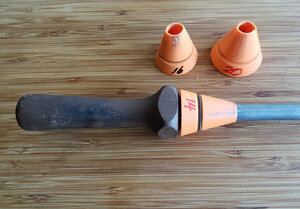I'm coming up on another round of whetstone sharpening for my softer steel inexpensive kitchen knives. They get used daily and only last 2-3 months before they need sharpening again. The last time I sharpened them took a little longer than necessary because I was chasing the bevel angle and getting the "feel" back. I ended up using a coarser stone than necessary, which will eventually wear the knife down. Hmmm, there's gotta be a solution.
Decided to buy myself an early $13 gift for Christmas off Amazon: WedgeK angle guides. Each guide is only about an inch wide and a little longer, but it is enough to both test the bevel angle of a knife and set the correct angle as you start sharpening.
I used a marker on the bevel of a cheap 6" vintage Burrell utility knife. Started with the 16° wedge and stroked it 3-4 times on an 8000 grit dry whetstone. Examined the edge under a jeweler's loupe and could easily see it was too shallow (ink still on edge).
Moved up to the 18° wedge, re-marked the knife edge, and ran it 3-4 times on the dry whetstone. Result was clean bevel right to the edge. I realized right then I could save myself time and knife/whetstone wear by starting with the correct sharpening angle.
My kitchen knife collection has published bevel angles of 11° to 16° per side. I have several vintage knives by Olympia (made in Japan) that I have no idea of the actual bevel angle. I sharpened them by "feel." I'll test every knife like I did above and log each knife's side bevel angle. Are the wedges necessary? Nope, but they are another tool, like the jeweler's loupe, to take sharpening to the next level because a sharp kitchen knife is an absolute joy to use, and NOTHING I've PERSONALLY used to sharpen knives over the last few decades comes close to whetstone sharpening.
Merry Christmas Everyone
Ray



Amazon.com: Wedgek Angle Guides 10 to 20 degrees for Sharpening Knives on Stone, Blue : Tools & Home Improvement
Decided to buy myself an early $13 gift for Christmas off Amazon: WedgeK angle guides. Each guide is only about an inch wide and a little longer, but it is enough to both test the bevel angle of a knife and set the correct angle as you start sharpening.
I used a marker on the bevel of a cheap 6" vintage Burrell utility knife. Started with the 16° wedge and stroked it 3-4 times on an 8000 grit dry whetstone. Examined the edge under a jeweler's loupe and could easily see it was too shallow (ink still on edge).
Moved up to the 18° wedge, re-marked the knife edge, and ran it 3-4 times on the dry whetstone. Result was clean bevel right to the edge. I realized right then I could save myself time and knife/whetstone wear by starting with the correct sharpening angle.
My kitchen knife collection has published bevel angles of 11° to 16° per side. I have several vintage knives by Olympia (made in Japan) that I have no idea of the actual bevel angle. I sharpened them by "feel." I'll test every knife like I did above and log each knife's side bevel angle. Are the wedges necessary? Nope, but they are another tool, like the jeweler's loupe, to take sharpening to the next level because a sharp kitchen knife is an absolute joy to use, and NOTHING I've PERSONALLY used to sharpen knives over the last few decades comes close to whetstone sharpening.
Merry Christmas Everyone
Ray
Amazon.com: Wedgek Angle Guides 10 to 20 degrees for Sharpening Knives on Stone, Blue : Tools & Home Improvement
Last edited:






